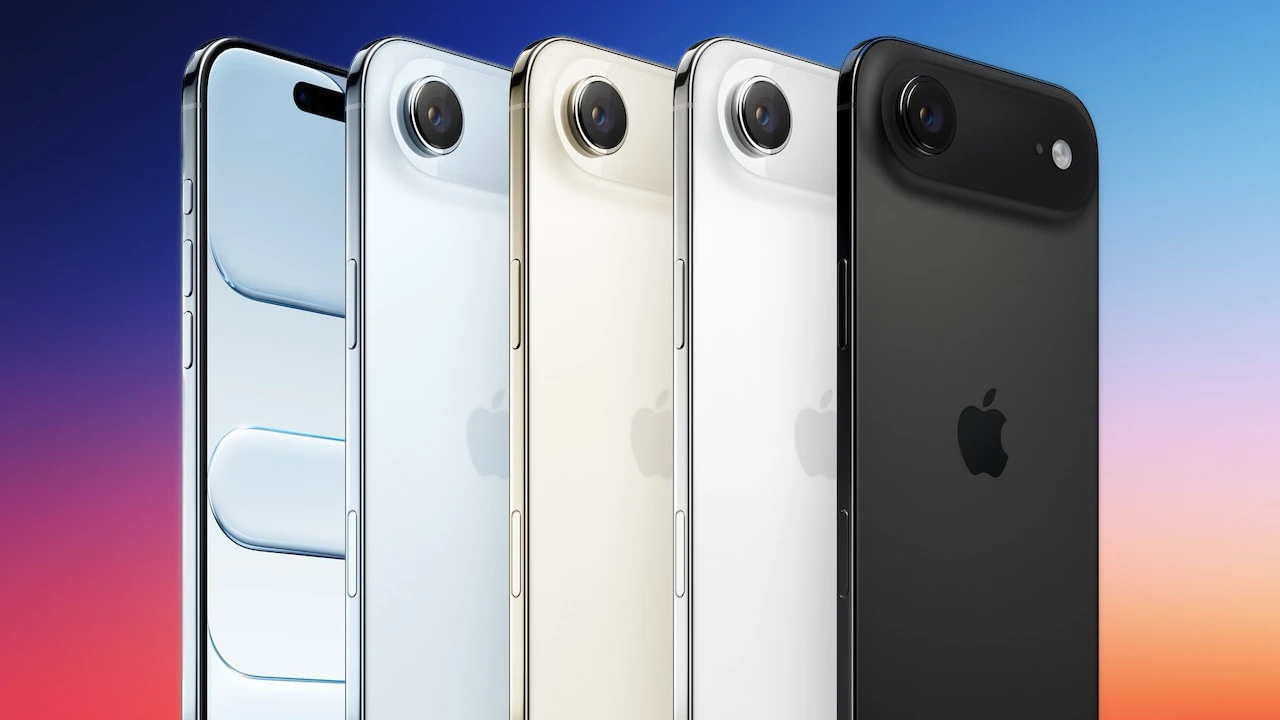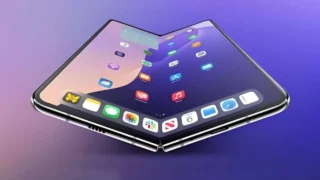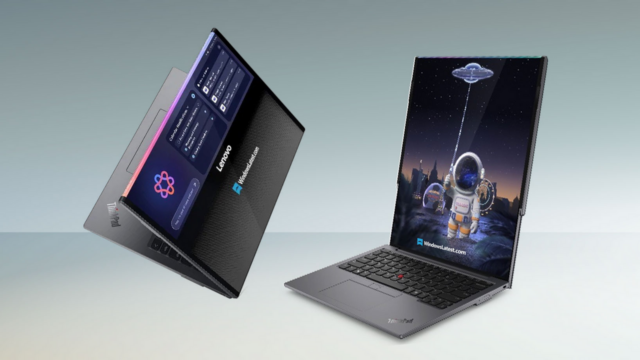At the Awe Dropping event, Apple signaled a radical shift in its phone strategy and introduced the iPhone Air, a breath of fresh air for the iPhone lineup. This device represents much more than a simple hardware update; it marks a bold new direction, replacing the Plus series, which failed to achieve the expected commercial success.
In a mature market where consumers are using their phones for longer and seeking stronger reasons to upgrade, Apple aims to appeal to users with this radical redesign. The company has chosen a different innovation path in the foldable phone arena, centering on the concept of impossible thinness. However, this strategy raises the most fundamental question in the tech world: Can an eye-catching form justify functional compromises?
Apple’s move represents a conscious shift away from the “bigger is better” philosophy. The unsuccessful Plus models, whose only distinguishing feature over the standard model was a larger screen, failed to offer a compelling value proposition for consumers.
Learning from this experience, Apple is now emphasizing thinness, a completely different physical attribute, rather than simply increasing size. This strategic pivot aligns the iPhone lineup with the MacBook Air and iPad Air, brands that have always been characterized by portability and stylish design over raw power or maximum features.
The iPhone Air is thus a fundamental rewrite of how Apple defines the non-Pro, large-screen phone segment. It’s a calculated move to create a new desirability factor, not just a need for an upgrade.
The Pinnacle of Design: Impossibly Thin and Premium Materials
The cornerstone of the iPhone Air’s identity is its physical design. At 5.6 mm, the device holds the title of Apple’s thinnest iPhone to date. To put this figure in perspective, the scale of the engineering achievement becomes even clearer when comparing it to models like the once-emblematic iPhone 6 (6.9 mm) and the previous-generation iPhone 16 Pro (8.25 mm). Despite this ultra-thin profile, Apple doesn’t compromise on durability. Ceramic Shield 2 and a polished titanium frame, used on both the front and back of the device, make it, Apple claims, “the most durable iPhone ever,” offering three times the scratch resistance.

Thinness meets lightness. Weighing just 165 grams, the iPhone Air is slightly heavier than the smaller iPhone SE (3rd generation, 144 grams), but it remains a featherweight compared to the Pro models. The device is available in four colors: Space Black, Snow White, Pale Gold, and Sky Blue.
One of the most controversial design elements is the single camera module, called a plateau, positioned in the center of the rear panel. One of the key compromises that made this thinness possible was the complete removal of the physical SIM card tray. This design, which only supports eSIM, is seen as part of Apple’s strategy to guide the industry towards a digital future.
The combination of these features positions the iPhone Air beyond being a mere technological device, as a marvel of industrial design, and even a fashion accessory. The device targets an audience that prioritizes cutting-edge design and portability over a multi-camera array. This appeals directly to the fashionista or design-focused consumer who prioritizes aesthetics and appearance, seeking the latest and most stylish design, rather than the typical tech-savvy profile. With this model, Apple isn’t just selling a phone; it’s introducing aesthetics and a new category of luxury technology.

Brilliant Display: ProMotion Technology and 3000 Nits of Brightness
One of the most striking features of the iPhone Air, and one that justifies its price, is undoubtedly its display. For the first time, Apple is changing the game by bringing ProMotion technology with a 120Hz adaptive refresh rate and Always-On Display to a non-Pro model. This feature has been a long-awaited feature on standard models for years, and it eliminates one of the key differentiators that previously drove consumers to the more expensive Pro series.
The device features a 6.5-inch Super Retina XDR OLED panel with a resolution of 2736 x 1260 pixels. This size places it in the ideal spot between the 6.3-inch iPhone 17 Pro and the 6.9-inch iPhone 17 Pro Max. The display’s technical superiority doesn’t stop there. Capable of reaching an incredible peak brightness of 3000 nits outdoors, the panel, with HDR support and an anti-reflective coating, promises excellent image quality in all conditions. Dynamic Island, which has become a standard feature, also takes its place on this screen.

The display is the cornerstone of the iPhone Air’s premium price tag. With a starting price of 97,999 TL, this model, significantly more expensive than the standard iPhone 17, makes significant compromises in areas like the camera and battery. To offset this higher price and compromises, Apple needed to offer a tangible, premium feature.
This is where the 120Hz ProMotion display comes into play, its fluidity and responsiveness instantly noticeable in daily use. This display isn’t just an upgrade; it’s the cornerstone of the Air’s marketing and pricing strategy. What users get for their money is a tangible “Pro” experience, intended to overshadow any other functional shortcomings.
Performance Monster: Pushing the Limits with the A19 Pro Chip
Behind its slimness, the iPhone Air hides a performance monster rivaling the Pro models. Apple, breaking with its recent strategy of giving standard models the same Pro chip as the previous year, breaks with this device. The iPhone Air is powered directly by the latest-generation A19 Pro chipset, also found in the iPhone 17 Pro and Pro Max. Featuring a 6-core CPU (2 performance, 4 efficiency) and a 5-core GPU, this chip promises to deliver the highest performance in the smartphone market.
This powerful processor is supported by 12GB of RAM, and storage options now start at 256GB, with larger capacities of 512GB and 1TB also available. This hardware not only delivers a smooth experience in everyday tasks and games, but also plays a critical role in effectively utilizing the new Apple Intelligence features introduced in iOS 26 and running on the device. There are also significant improvements in connectivity. Apple’s new C1X 5G modem, designed in-house, is claimed to be twice as fast and 30% more efficient, while the N1 chip supports the latest wireless standards like Wi-Fi 7 and Bluetooth 6.

Apple’s inclusion of the Pro chip in the Air is a deliberate strategic move. In the past, having the latest and fastest chip was a key reason to purchase the Pro model. Now, performance is no longer a differentiator between the Air and Pro models.
This forces consumers to base their decision almost entirely on other features, namely the camera system and battery life. By creating a performance equation, Apple simplifies the choice while simultaneously complicating it. It leaves consumers with a fundamental conflict: “Do I want the best performance in a thin body (the Air) with a compromised camera, or do I want the same performance in a thicker body (the Pro) with the best camera?” This is a deliberate strategy that directs users to make a choice based on lifestyle priorities rather than raw technical specifications.
Single Camera, Big Capabilities: The iPhone Air’s Fusion Camera System
The iPhone Air’s most controversial and biggest compromise is undoubtedly its camera system. The device comes with a single 48MP “Fusion” main camera with an ƒ/1.6 aperture and sensor-based optical image stabilization. Apple relies on computational photography capabilities to deliver versatility with this single lens. It claims to provide a 2x “optical quality” telephoto zoom equivalent to 52mm by cropping the sensor, allowing users to take super-high-resolution photos at 24MP and 48MP.
However, the slimness comes at the price of ultra-wide-angle and dedicated telephoto lenses. This means that while even the standard iPhone 17 features a dual camera, the Air is a step behind in hardware. Apple is making a bold claim that the A19 Pro chip and advanced image processing algorithms can compensate for this hardware shortcoming.
Marketing terms like Fusion Camera reflect the company’s belief that software can transcend hardware limitations. This is a high-risk gamble, reminiscent of Google’s years-long strategy of competing with a single lens and superior software on Pixel phones.
On the front, the situation is quite the opposite. The device receives a significant upgrade with an all-new selfie camera with either 18MP or 24MP resolution (sources vary). Features like autofocus, Center Stage (automatically adjusting the frame during video calls), and taking landscape selfies without rotating the phone offer valuable innovations, especially for content creators. On the video front, the rear camera can record 4K Dolby Vision at 60 frames per second, while “Dual Shot” mode is available.
Thanks to this feature, it’s possible to record video simultaneously with the front and rear cameras.
The Price of Thinness: Battery Performance and Charging
The biggest concern for potential buyers is the iPhone Air’s battery life. The thinner chassis naturally comes with a smaller battery. The device is reportedly equipped with a capacity of approximately 3149 mAh, which is lower than other models in the series. While Apple promises “all-day battery life” thanks to the efficiency improvements brought by the A19 Pro chip and the new C1X modem, the actual numbers paint a clearer picture.

The device’s video playback time is stated as up to 27 hours. This, compared to the approximately 30 hours of the standard iPhone 17 and the 33 hours of the iPhone 17 Pro, indicates that the Air has a significant battery disadvantage. This directly contradicts one of the top priorities of consumers.
Surveys and market research show that while users theoretically want thinner phones, in practice they overwhelmingly prefer better battery life. The iPhone Air forces users to choose between these two opposing desires. When it comes to charging, the device supports fast charging and MagSafe wireless charging technologies, providing a 50% charge in 30 minutes.
This battery combination also necessitates a new accessory ecosystem for Apple. The physically smaller battery has the potential to create “battery anxiety” during heavy use or long days without a charging option.
The most obvious solution to this problem is an external power source, such as Apple’s high-margin MagSafe Battery Pack. While some sources indicate that Apple will sell a dedicated “power pack” for this model, user feedback confirms this is an expected solution. Therefore, the iPhone Air’s fundamental design compromise transforms a limitation into a commercial opportunity, increasing the sales potential of another Apple product. The paradox of “buying a thin phone and putting a battery on the back” will be one of the most significant points of contention for this model.
iPhone Air Turkey Price and Release Date
Apple has announced the iPhone Air’s sales process in Turkey, in line with its global launch schedule. Pre-orders for the device will begin on September 12th, and it will hit shelves on September 19th. Pricing, the most important piece of information for tech enthusiasts in Turkey, has also been officially announced.
The iPhone Air is available in three different configurations, each with an increased starting storage capacity. Prices are determined by storage capacity as follows:
Comparative Analysis: iPhone Air vs. Its Competitors
Intra-Family Competition: iPhone 17 vs. iPhone 17 Pro
To understand the value of the iPhone Air, it’s crucial to compare it to other models in its family.
iPhone Air vs. iPhone 17: The Air features a larger and more advanced ProMotion display and a faster A19 Pro chip compared to the standard model. However, the standard iPhone 17 stands out due to its more affordable price, more versatile dual-camera system (including an ultra-wide angle), and better battery life. This makes the standard iPhone 17 a logical choice for pragmatic users seeking a better price-performance ratio.
iPhone Air vs. iPhone 17 Pro: Both models share the A19 Pro chip and ProMotion display. However, for the relatively small price difference, the iPhone 17 Pro offers professional features such as a far superior triple-camera system including a telephoto zoom lens, significantly better battery life, a LiDAR sensor, and a potentially faster USB-C port. This makes the iPhone 17 Pro more attractive to users seeking maximum functionality and versatility.

Android Arena: Samsung vs. Google
The iPhone Air is also in direct competition with its strongest rivals in the Android ecosystem.
Samsung Galaxy S26 / S26 Edge: The competition revolves around design. Both Apple and Samsung are focusing on ultra-thin designs, and the Galaxy S26 Edge is rumored to be 5.5 mm thick. However, Samsung is expected to maintain its camera versatility even in its thinner models. This highlights the starkness of Apple’s compromises with the Air.
Google Pixel 10 Pro: The Pixel is positioned as a smart camera phone and features software features like advanced AI-powered zoom. It stands out with its features. While the iPhone Air competes with raw processing power (A19 Pro vs. Tensor G5) and industrial design, the Pixel offers a different philosophy, including camera intelligence and a pure Android experience. Meanwhile, upgrades from the standard iPhone 17, such as a 120Hz display and 256GB of initial storage, make it a much stronger competitor to the base model Pixel 10 than in previous years, further solidifying the Air’s premium position.
Who is the iPhone Air Ideal for? Is It Worth Buying?
In light of all this analysis, the answer to the question “Should I buy an iPhone Air?” isn’t a simple yes or no. This device is a niche masterpiece designed for a specific user profile. The evaluation depends entirely on personal priorities.
Who Should Buy an iPhone Air?
This device is an ideal choice for users who:
- Put aesthetics, the latest design, and portability above all else. Want the thinnest, most modern-looking phone available.
- Those who value a high-end processor and a large, smooth 120Hz display for daily tasks, media consumption, and gaming.
- Casual photographers who typically use the main camera, don’t need features like ultra-wide or telephoto zoom, and are happy with high-quality, instant photos.
- Those who aren’t power users or are open to using an external battery pack like the MagSafe Battery Pack for extended periods.
- Those who have the budget for a premium phone but don’t need the top-tier camera system offered by the Pro models.
- Who Should Avoid?
- Photography enthusiasts, professional or semi-professional content creators, users who demand maximum battery life, and those looking for the best price-performance ratio should instead opt for the iPhone 17 Pro or even the standard iPhone 17.
The iPhone Air is a stunning engineering achievement and an aesthetically stunning device. However, its functional compromises in the camera and battery make it a questionable choice for the average user at its higher price point.
If you fit the specific user profile outlined above, the iPhone Air could be a great buy for you. For everyone else, the iPhone 17 Pro offers a much more complete package for a small price difference, while the standard iPhone 17 offers more versatility at a lower cost. Ultimately, the best answer to the question of whether it’s worth buying is: It depends on your priorities.













